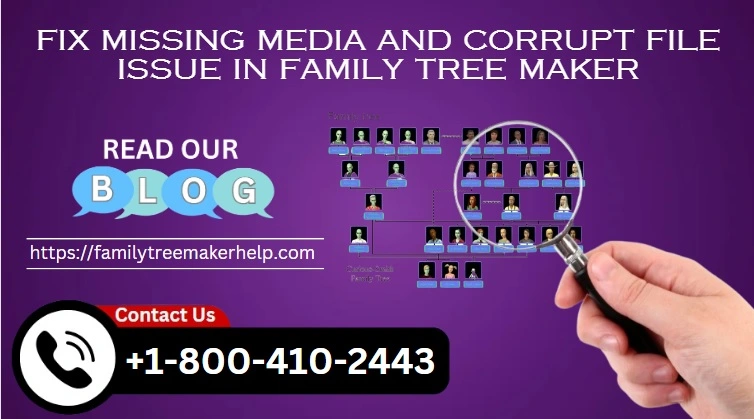You will discover how to Fix missing media and corrupt files in this article. The steps to fix missing media and corrupt files are shown below. Media files play a significant role in Family Tree Maker. As it will display the index’s picture. Also, on FTM 2017, media files can be .jpeg .png .pdf, and so on.
When the files from the source destination or computer are missing or corrupt. These files will not appear in the tree and will instead appear as a magnifying icon on the media tab of FTM 2017.
We can see that when we click on these files, it says “files not found.” So, before you move your media files from one folder to another, keep this in mind. We must exercise extreme caution. To avoid problems like these, we need to add the new directory to the FTM 2017 media files tab.
Fix Missing Media and Corrupt Files in Family Tree Maker
Under the Media tab, you can fix missing media and corrupt files. This is where you’ll discover all of your tree’s available media and related files.
Also, by default, a folder called Family Tree Maker is created on your document. Within this folder, you can save a folder of media with your tree names. As a result, you can also alter and modify your media file from this location.
To avoid this problem in the future, please do a full backup when your tree is in good condition. Because if a problem arises in the future, you may recover your system using this backup file.
Second, if you use an anti-virus tool to scan your computer for viruses, please be cautious before deleting or moving the file to quarantine as a consequence of the scan because the file could be part of your media, so please be cautious.
How to Fix Missing Media and Corrupt Files on Windows 10?
Due to missing or corrupt data, Windows 10, or any operating system for that matter, might develop issues or crashes over time and usage. If you’re not sure how to remedy the problem of this missing file, Windows 10 includes a number of failsafe commands that ensure you can always solve such problems without losing any data.
Let us introduce you to some of the most effective solutions for resolving the missing files problem in Windows 10 on your computer:
Use System File Checker (SFC):-
The System File Checker function, sometimes known as SFC, is software that may analyze and fix missing media and corrupt files on Windows 10 by replacing data from the cache, which saves backup files for safekeeping within the operating system.
- By clicking on the Start menu, or by pressing the Windows key and typing cmd into the search box, you can access the Start menu. Run as Administrator by right-clicking on the Command Prompt software.
- Type the command SFC/Scannow into the Command Prompt and hit Enter.
- The System will start the verification process, which will detect any corrupt or missing files and assist you in resolving the issue.
- If no corrupt files are discovered, the report will state, “Windows Resource Protection did not locate any integrity breaches.” If the SFC scan finds and fixes the problem, the report will say “Windows Resource Protection found corrupt files and successfully fixed them.” The SFC should be run three times or more if errors are identified.
Use DISM Command:-
The tool Deployment Image Servicing and Management, or DISM, has the ability to bypass the System File Checker because the SFC relies exclusively on the replacement file held in the cache. However, if they are likewise corrupted, the SFC protocol will fail. This is when the DISM comes into play, downloading the essential files from the Windows Update servers to service the Windows image file.
Check health, ScanHealth, and RestoreHealth are the three commands that must be run in the order listed above. CheckHealth is a simple scan that does not resolve the issue, but ScanHelth is an advanced scan that detects deeply embedded problems. The command RestoreHealth would start the process of resolving the problems.
Step 1 – CheckHealth Command:-
- Open the Start menu and search for cmd in the search field. Select Run as Administrator from the context menu of the Command Prompt app.
- Press Enter to run the command DISM /Online /Cleanup-Image /CheckHealth.
- The results will tell you if any corrupted files were found. “No component store corruption found” says the message, indicating that the Windows image is in good working order. Proceed to the next step if the corrupted/missing file is found.
Step 2- ScanHealth Command:-
- Open the Start menu and search for cmd in the search field. Select Run as Administrator from the context menu of the Command Prompt app.
- Press enter to run the command DISM/Online /Cleanup-Image /CheckHealth.
- Because this is a comprehensive scan, it may take some time to finish.
- Now you can see the scan results, which will show you the damaged files that were discovered during the scan. If it says so, “There was no evidence of component store corruption. “The Windows image will now operate normally,” the operation concluded successfully.
Step 3 – RestoreHealth Command:-
- Open the Start menu and search for cmd in the search field. Select Run as Administrator from the context menu of the command prompt app.
- Press Enter to run the command DISM/Online/Cleanup-Image/Restorehealth.
- Once the restoration operation has been finished successfully, the system will notify you.
Conclusion
This is all about how to fix missing media and corrupt files. If you face any problem then you can take support on Live Chat.
Also Read:-


Why is my FTM stuck in the Index portion. It has been “winding” in that section for over an hour.
Can I please get some help with this?